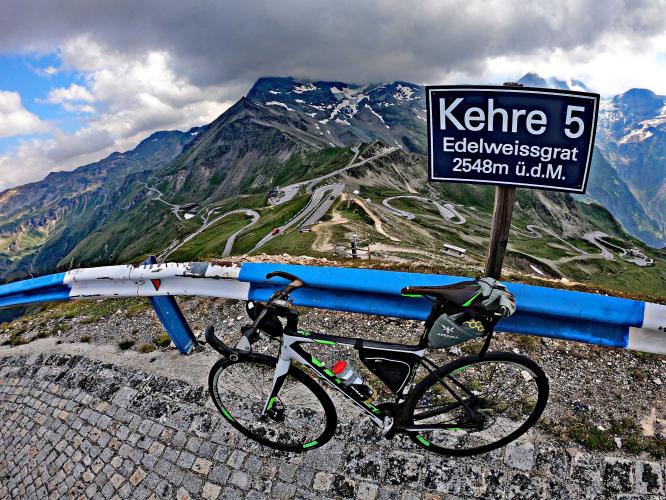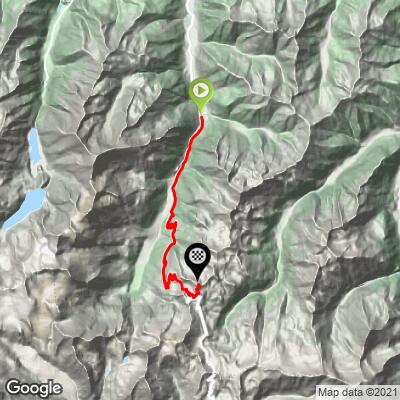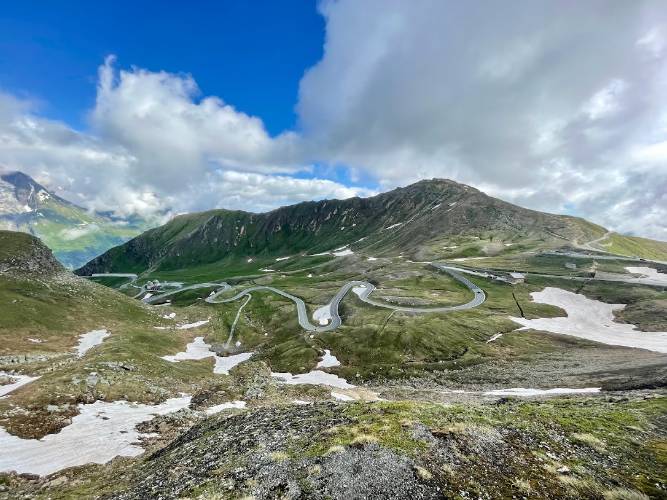![Cycling Grossglockner (Grobglockner) from Fusch, Austria panoramic view of Austrian alps]()
Cycling Grossglockner (Grobglockner) from Fusch
Ride 18.5 kilometers gaining 1,647 meters at 8.9% average grade.
This is a simply spectacular bike climb on one of the greatest roadways in the world. Grossglockner from Fusch is ranked #52 in the world and #5 in Austria.
![Cycling Grossglockner (Grobglockner) from Fusch, Austria photo collage; roadway switchbacking up mountainside, signs for Kehre 1 Piffalpe; Grobglockner Hochalpenstrabe]()
![Cycling Grossglockner (Grobglockner) from Fusch, Austria road sign for leaving Fusch]()
Climb begins just south of Fusch.
Grobglockner is the highest mountain in Austria, and the road over it is an engineering marvel. The road surface is impeccable and affords many nice views of the surrounding mountains along the way.[1] The climb is very challenging, averaging nearly 9% over 11.5 miles. Grobglockner from the Fusch (north) side is ranked #28 on our Top 100 World Climbs List (from Pockhorn it is ranked #92; see the Grobglockner from Pockhorn climb page for more information).
![Cycling Grossglockner (Grobglockner) from Fusch, Austria toll booths]()
No charge for cycles 2017 but as of 2022 we cannot confirm that there is no charge.
Official site
![Cycling Grossglockner (Grobglockner) from Fusch, Austria toll gate at kilomter 4.3 just before road pitches up]()
Toll gate is at kilometer 4.3 just before the road pitches up -
The final 14 kilometers average 9.7%.
The grade is nearly constant throughout the climb, with the average for the steepest quarter-mile being 11.67%, steepest mile 10.76%, and steepest stretch over a 2.5 mile run is 10.1%. Other than a respite through the hairpins (kehres), there is no relief from the double digit grade.
![Cycling Grossglockner (Grobglockner) from Fusch, Austria gorgeous views along the middle portion of the climb; Austrian alps]()
Middle portion of the climb.
![Cycling Grossglockner (Grobglockner) from Fusch, Austria photo collage of the Glockner Group fo the Hohe Tauern range of the Austrian Alps]()
Grossglockner is part of the Glockner Group of the Hohe Tauern range of the Alps.
![Cycling Grossglockner (Grobglockner) from Fusch, Austria Austrain Alps]()
Final section before the turn off and final two kilometers to Eidelwilbspitze.
This was an exceptional climb with magnificent views of the valley as we climb, and then the mountains above us that we ascend to. This is one of the most perfectly engineered roads in the world and the switchbacks become part of the wonderful scenery.
![Cycling Grossglockner (Grobglockner) from Fusch, Austria Kehre signs along the route. Kehre means hairpin]()
14 kehres (hairpins) on main route (first 17 km).
![Cycling Grossglockner (Grobglockner) from Fusch, Austria Kehre signs along the route. Kehre means hairpin]()
Kehre 1 is at the start and 14 is at the finish of Grossblockner, just before the turn to Edelweissspitze.
![Cycling Grossglockner (Grobglockner) from Fusch, Austria European flags line the roadway at the climb finish]()
Turn left at kilometer 17 for the last spectacular segment of this exceptional bike climb.
![Cycling Grossglockner (Grobglockner) from Fusch, Austria Kehre signs along the route. Kehre means hairpin]()
Six more on the 1.6 km to Edelssspitze.
![Cycling Grossglockner (Grobglockner) from Fusch, Austria cobblestone segment at the end, along with multiple hairpin turns]()
The last segment is all cobbles.
PJAMM Cyclist Ties Arts writes, “The final segment of the climb (extension) to the Edelweissspitze is unique, turning to cobblestones and increasing the grade even more. I must admit this was one of the best five climbs in my life so far. Any climber interested in a unique, scenic, and special challenge/adventure, should put Grobglockner on their Bucket List.”
![Cycling Grossglockner (Grobglockner) from Fusch, Austria PJAMM Cyclist stands at climb finish]()
Finish.
![Cycling Grossglockner (Grobglockner) from Fusch, Austria alp views from the climb finish]()
Views from the top.
Our cycling friend and #1 contributor to Top 100 World Climbs, Ties Arts (Netherlands) provides this summary of his ride up the Grobglockner:
![Cycling Grossglockner (Grobglockner) from Fusch, Austria PJAMM Cyclist at climb finish]()
Ties at Edelweissspitze (the climb’s top).
In the summer of 2018 around 1:30 pm, I began my ride up this incredible road from the Fusch side (the late start due to having done the mighty Grosser Oscheniksee in the morning).
The weather was very hot that day (almost 40 degrees celsius/104 fahrenheit in Fusch!). However, I was determined to climb one of Europe’s most famous roads. And what a joy it was…and what a pain it was as well. I was on a rental, a Kona ‘Jake the Snake’ cyclocrosser with a 34X34 cassette, which is unfortunately a heavy, 10kg+ bike.
The moment you enter the official part of the road (going through the gateway) it really starts. From “Kehre 1” (switchback #1) the grade never falls below 9%, and I mainly saw double digits on my Garmin as I made my way up the mountain in the stifling heat. Climbing a Hors Category climb in 35 degrees Celsius is always tough -- your body just gets exhausted faster. Hydrating regularly is critical.
![Cycling Grossglockner (Grobglockner) from Fusch, Austria bike parked in front of summit sign]()
Summit sign
Photo contributed from Erwan Treguier.
Every year there is a bike event here called Glocknerkönig, which is a bike-only, car-free, day up the Grossglockner-Hochalpenstrasse (High Alpine Road) below the Grossglockner mountain. At 3798 metres, it’s the highest peak in Austria.
![Cycling Grossglockner (Grobglockner) from Fusch, Austria gorgeous roadway on this Austrian alp climb]()
Of the road, Wikipedia notes:
“Mass tourism was decisively promoted by the scenic High Alpine Road (Großglockner-Hochalpenstraße) running from Heiligenblut to Bruck in Salzburg with a branch-off to the Franz-Josefs-Höhe viewpoint. It was built across the historic Hochtor Pass of the Alpine divide between 1930 and 1935 according to plans designed by engineer Franz Wallack. The pass road, Austria's highest, reaches 2,576 m (8,451 ft), and is one of the most popular tourist attractions in the country (second after Schönbrunn Palace) with about 270,000 vehicles and 900,000 visitors every year, about 50 million since its opening” (Wikipedia - Grobglockner).
[1] We know the views are exceptional because the day before the climb when we descended this side of the pass in an automobile it was clear, though our ride the following day was during continual rain.

 We've partnered with Sherpa-Map.com to bring you the best route planning tool. With a PRO Membership you can use this climb as a reference when creating your route.
We've partnered with Sherpa-Map.com to bring you the best route planning tool. With a PRO Membership you can use this climb as a reference when creating your route. 





